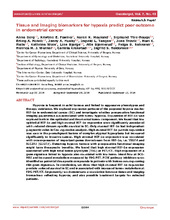Tissue and imaging biomarkers for hypoxia predict poor outcome in endometrial cancer
Berg, Anna; Fasmer, Kristine Eldevik; Mauland, Karen Klepsland; Ytre-Hauge, Sigmund; Høivik, Erling Andre; Husby, Jenny Hild Aase; Tangen, Ingvild Løberg; Trovik, Jone; Halle, Mari Kyllesø; Woie, Kathrine; Bjørge, Line; Bjørnerud, Atle; Salvesen, Helga; Werner, Henrica Maria Johanna; Krakstad, Camilla; Haldorsen, Ingfrid S.
Peer reviewed, Journal article
Published version

Åpne
Permanent lenke
https://hdl.handle.net/1956/16366Utgivelsesdato
2016-09-13Metadata
Vis full innførselSamlinger
Originalversjon
https://doi.org/10.18632/oncotarget.12004Sammendrag
Hypoxia is frequent in solid tumors and linked to aggressive phenotypes and therapy resistance. We explored expression patterns of the proposed hypoxia marker HIF-1α in endometrial cancer (EC) and investigate whether preoperative functional imaging parameters are associated with tumor hypoxia. Expression of HIF-1α was explored both in the epithelial and the stromal tumor component. We found that low epithelial HIF-1α and high stromal HIF-1α expression were significantly associated with reduced disease specific survival in EC. Only stromal HIF-1α had independent prognostic value in Cox regression analysis. High stromal HIF-1α protein expression was rare in the premalignant lesions of complex atypical hyperplasia but increased significantly to invasive cancer. High stromal HIF-1α expression was correlated with overexpression of important genes downstream from HIF-1α, i.e. VEGFA and SLC2A1 (GLUT1). Detecting hypoxic tumors with preoperative functional imaging might have therapeutic benefits. We found that high stromal HIF-1α expression associated with high total lesion glycolysis (TLG) at PET/CT. High expression of a gene signature linked to hypoxia also correlated with low tumor blood flow at DCE-MRI and increased metabolism measured by FDG-PET. PI3K pathway inhibitors were identified as potential therapeutic compounds in patients with lesions overexpressing this gene signature. In conclusion, we show that high stromal HIF-1α expression predicts reduced survival in EC and is associated with increased tumor metabolism at FDG-PET/CT. Importantly; we demonstrate a correlation between tissue and imaging biomarkers reflecting hypoxia, and also possible treatment targets for selected patients.
